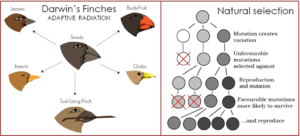Adaptive Action: Difference between revisions
mNo edit summary |
mNo edit summary |
||
| Line 5: | Line 5: | ||
Adaptive actions are driven by natural selection, whereby individuals with traits or behaviors that confer a higher fitness have a greater chance of surviving and passing on their genes to the next generation. Over time, through the accumulation of beneficial genetic variations, populations can undergo adaptive evolution and become better suited to their specific ecological niches. | Adaptive actions are driven by natural selection, whereby individuals with traits or behaviors that confer a higher fitness have a greater chance of surviving and passing on their genes to the next generation. Over time, through the accumulation of beneficial genetic variations, populations can undergo adaptive evolution and become better suited to their specific ecological niches. | ||
Latest revision as of 23:43, 25 August 2024
Adaptive action in evolution refers to the process by which organisms modify their behavior or physiological traits in response to changes in their environment which increase their possibility of replication. It is a key mechanism through which species can improve their chances of survival and reproductive success.
When faced with new challenges or opportunities in their environment, organisms may exhibit adaptive actions that allow them to better exploit available resources, avoid predators, or enhance their reproductive capabilities. These actions can include changes in foraging strategies, migration patterns, mating behaviors, or physiological responses.
Adaptive actions are driven by natural selection, whereby individuals with traits or behaviors that confer a higher fitness have a greater chance of surviving and passing on their genes to the next generation. Over time, through the accumulation of beneficial genetic variations, populations can undergo adaptive evolution and become better suited to their specific ecological niches.
